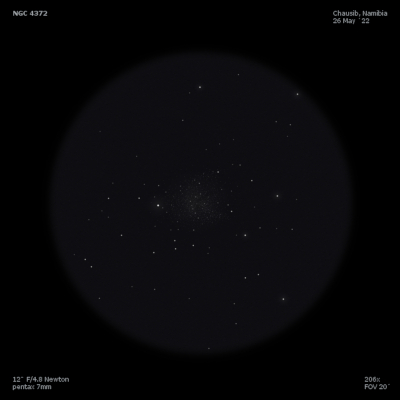
10x30mm Canon IS (3/28/19 - Tasmania): faint, low surface brightness glow with no core. Attached to the south of a mag 6.6 star that is close to the end of the "Dark Doodad".
James Dunlop discovered NGC 4372 = D 67 = h3390 on 30 Apr 1826 using his 9-inch f/12 speculum reflector from Parramatta, NSW. He described "a star of the 6th magnitude, with a beautiful well-defined milky ray proceeding from it south following; the ray is conical, and the star appears in the point of the cone, and the broad or south following extremity is circular, or rounded off. The ray is about 7' in length, and nearly 2' in breadth at the broadest part, near the southern extremity. With the sweeping power this appears like a star with a very faint milky ray south following, the ray gradually spreading in breadth from the star, and rounded off at the broader end. But with a higher power it is not a star with a ray, but a very faint nebula, and the star is not involved or connected with it: I should call it a very faint nebula of a long oval shape, the smaller end towards the star; this is easily resolvable into extremely minute points or stars, but I cannot discover the slightest indications of attraction or condensation towards any part of it. I certainly had not the least suspicion of this object being resolvable when I discovered it with the sweeping power, nor even when I examined it a second time; it is a beautiful object, of a uniform faint light." Dunlop's position is 24' too far WNW (a fairly large error), but the mag 6.6 star near the NW edge clinches the identification. His sketch is shown in Fig. 2 of his catalogue.
John Herschel described it (1 Apr 1835) as "a globular cluster, very faint; large; very gradually brighter in the middle; 6' diameter; resolved into stars of 15th magnitude; rich in stars; a delicate and faint object; has a star 45 N.p., distance 5' from centre. Almost perfectly insulated in a very large space almost entirely devoid of stars, being the smaller and southern lacuna below the great 'coal sack'."
400/500mm - 18" (7/6/05 - Magellan Observatory, Australia): at 171x, this large, bright globular was an impressive object and beautifully resolved into 150-200 stars mag 13 and fainter, within a 13'-14' diameter. The unresolved background glow was relatively faint for such a well-resolved globular. The large 4' core was only slightly brighter and there was no nucleus (class 12 concentration), although a close pair of brighter mag 12.5 stars is near the center. Scores of stars appeared linked in chains and loops, particularly in the outer halo, which is quite irregular and ragged. Mag 6.6 HD 107947 lies 5.5' NW of center at the edge of the halo and provided a striking contrast although it detracted somewhat from viewing. A dust lane appeared to pierce the cluster on the north side for a few arc minutes (east of the bright star) and this dark intrusion may be an extension of the "Dark Doodad" (see notes).
18" (7/7/02 - Magellan Observatory, Australia): at 228x, this large, loose globular was well-resolved into ~100 stars mag 12-15 with a 12' diameter. The roundish core is ~4' in size with many faint stars sprinkled across the core. The halo is elongated and irregular in shape. A starless dark lane appears to wind into the cluster towards the core from the NW side angling roughly NW-SE (later verified on the DSS). A mag 6.8 star lies 5' NW of the core and interferes with viewing! Located 44' SW of mag 3.8 Gamma Muscae.
600/800mm - 24" (4/12/08 - Magellan Observatory, Australia): at 260x, NGC 4372 is a highly-resolved, low-concentration class globular. A mag 6.6 star just 5.5' NW of center was a bit distracting but scores of stars were resolved over the 4' core, appearing to criss-cross the center in numerous lanes. The outer halo was very large, nearly 15' in diameter, and resolved into a couple of hundred stars. Except for the brighter and denser core, this globular appeared similar to a very large, fully resolved open cluster.
Notes by Steve Gottlieb